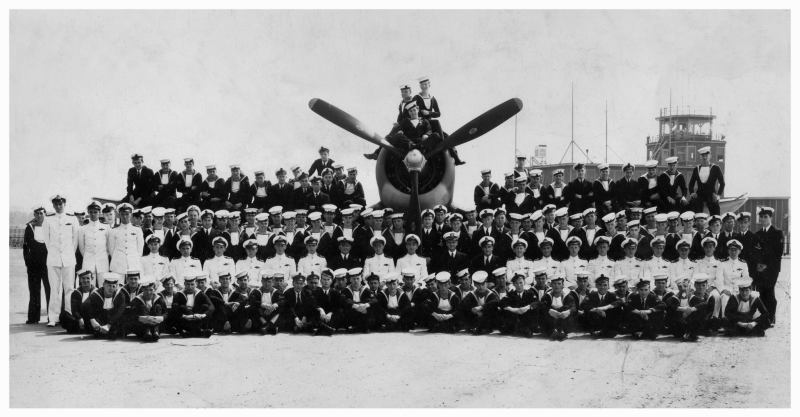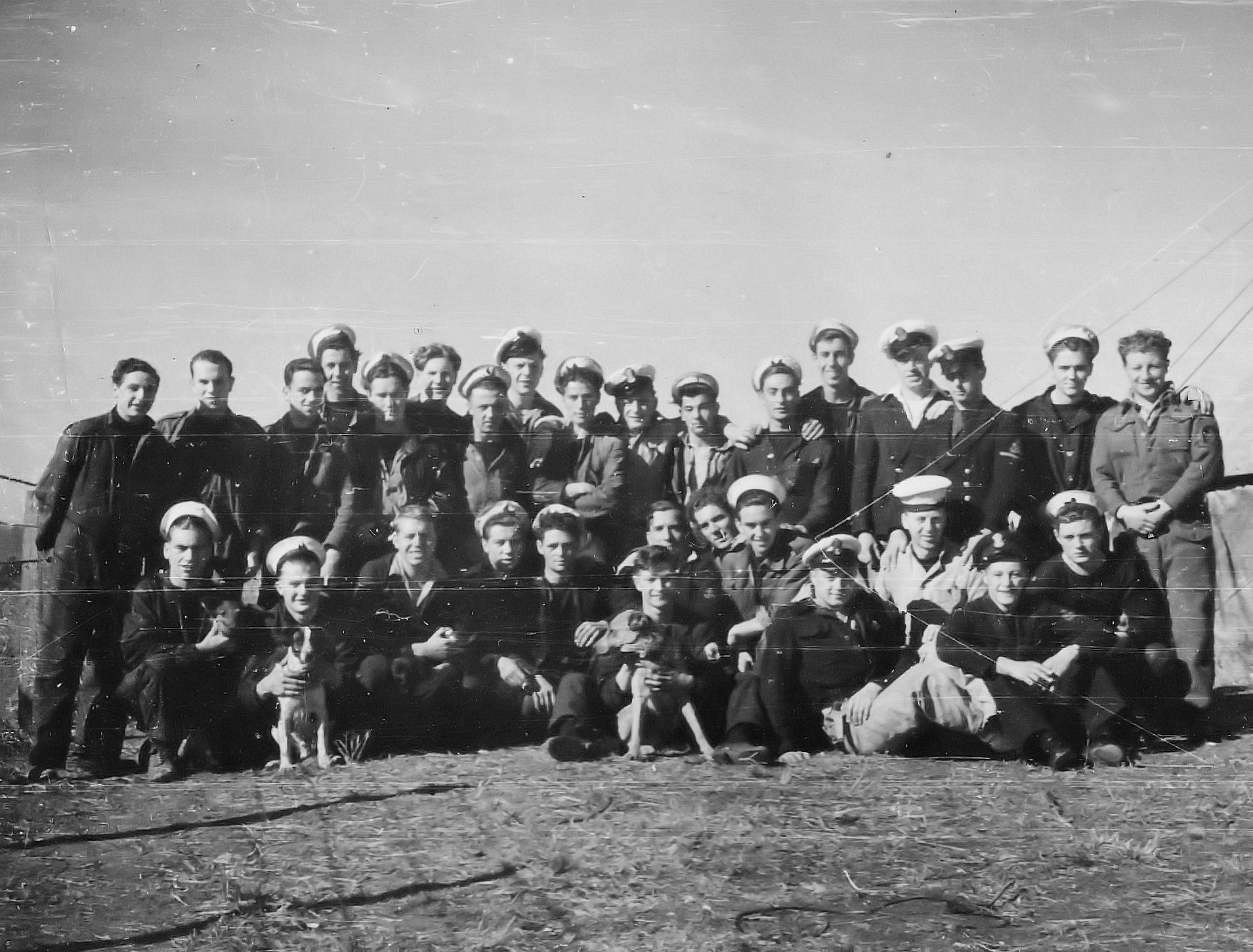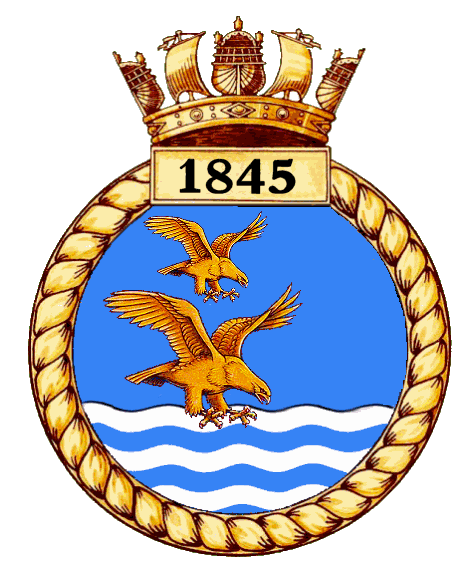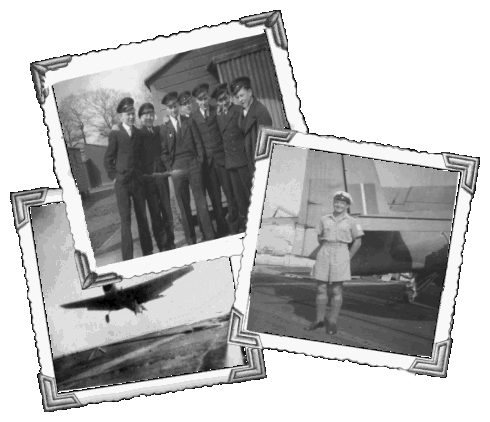|
1845 (1) June 1944 - April 1945
Formation and work-up
The personnel for 1845 Squadron assembled at Townhill Camp in May 1944, and sailed for the USA to form and train. The squadron officially formed on June 1st 1944 at
USNAS Brunswick as a single seat fighter squadron under the command of Lt. Cdr (A) D.G. Parker RNVR. The squadron was issued with 18 Corsair IIs. After familiarisation with the aircraft and equipment the squadron began training in earnest to prepare for active service. Training included navigation exercises, low flying, formation flying and combat tactics.
 |
|
The personnel of 1845 Naval Air Squadron at U.S.
Naval Air Station Brunswick. Click image to see
larger version |
On July 3rd the squadron began practicing ADDLs (Aerodrome Dummy Deck Landings) utilising the nearby US Naval Auxiliary Airfield at Bar Harbour, Maine, returning to
Brunswick on the 7th.
1
Usually the squadron would have conducted DLT (Deck Landing Training) on the training carrier the USS CHARGER, operating in Chesapeake Bay but there is no record of this happening.
The first month of flying was a difficult time for the new pilots, many of whom were on their first operational squadron; there were 8 aircraft accidents recorded during the work up period; the first was on June18th when Sub-Lt D. Baldwin RNVR hit a derelict house near the airfield soon after taking off in JS832, he was unhurt. Sub-Lt J.C. Leddy
RNVR also hit an immovable object with his Corsair on July 1st, flying in JS815 he struck a treetop on low flying exercise damaging a mainplane but landing safely. On July 7th Sub-Lt F.K. Barlow
RNVR nosed over taxying in JS817 damaging the prop while Sub-Lt R.L. Goulden
RNVR in JS817 landed with the tail wheel retracted on the 13th.Sub-Lt Leddy had a second accident on July 15th, this time flying in JS809, he stalled above the runway and damaged his port wingtip, on the same day Sub-Lt P.E. Abbott RNVR made a heavy landing in JS819, the aircraft bounced and damaged the prop. Sub-Lt J. Blade RNVR had to land JS81I with its tail wheel retracted on July 17th and Sub-Lt H.W. Marsh RNVR stalled on approach in JS820 on the 29th, damaging a wing tip.
On completion of working up at
USNAS Brunswick1845 moved to
USNAS Norfolk in late August 1944 in preparation for passage to the UK aboard the escort carrier
HMS PUNCHER which arrived at Norfolk on August 27th in preparation for loading a ferry cargo for delivery to the UK.
2
It is possible that the squadron conducted limited DLT (Deck Landing Training) on PUNCHER prior to loading. They must have flown to USNAS Norfolk prior to August 30th in order to be embarked but there is no information to support this.
PUNCHER secured alongside at Norfolk Naval Operating Base on the 30th to begin loading; eighteen corsairs and equipment of 1845 squadron were hoisted on-board first and stowed in the hanger, then a deck cargo of Hellcats, Avengers, Corsairs and one Helldiver. Twenty-one officers and 128 ratings of 1845 also came on board before the ship sailed on to New York.
The ship arrived at the 35th Street Pier, Brooklyn, at 1800 on September 1st to undergo voyage repairs and to embark more passengers, including twenty-eight women and children. Repairs were completed on the 3rd and
PUNCHER prepared to sail with the 40 ship UK bound convoy CU-38 sue to depart from New York the nest day. Sailing was delayed however as the ship had to wait delivery of a consignment of special ammunition and sailed a day later with the destroyer USS ENRIGHT as escort, sighting the convoy late in the morning on the 9th. Approaching Bishop Rock on the 14th, the convoy split into two groups; and
PUNCHER became commodore of a thirty ship group headed for the Liverpool. Others were bound for Southampton and Bristol.
PUNCHER berthed at King George V dock, Glasgow, on September 15th having parted company with the convoy in Liverpool Bay. Unloading began immediately. 1845 squadron was disembarked to
RNAS Eglinton, Northern Ireland.
3
It is unclear whether the aircraft were unloaded in Glasgow and towed to Renfrew airport for onward flight to RNAS Eglinton or launched from PUNCHER.
The 10th Naval Fighter Wing and HMS SLINGER
The squadron arrived at
RNAS Eglinton on September 18th and training intensified. The squadron was earmarked to join an escort carrier for service with the British Pacific Fleet and on October 14th 1944 No. 1845 together with 1843 squadron formed the 10th Naval Fighter Wing at
Eglinton; 1843 was allocated to the escort carrier HMS
ARBITER and 1845 for
HMS SLINGER. On the 23rd both squadrons moved to
RNAS Ayr for bombardment spotting training, 1845 returned to
Eglinton on November 6th. During this training Corsair JS813 was badly damaged when a 25-pdr shell hit and damaged the tail & rudder on November 3rd, the pilot Sub-Lt T.F. Pocock RNVR was unhurt. There were two other aircraft incidents while ashore at Eglinton; Sub-Lt G.F.G. Showell RNVR while taxiing in JS809 collided with a stationary aircraft on the runway on October 27th and on November 14th JS817 flown by Sub-Lt R.W. Chambler RNVR crashed on the runway when the port oleo folded on landing.
Later in November the squadron strength was increased to 24 aircraft when it absorbed part of
1848 squadron which was disbanded on November 21st, its aircraft and pilots being shared equally between Nos.1843, 1845 and
1846 Squadrons bringing them up to 24 aircraft each. These were Corsair Mk. IIs however and were on strength for a matter of weeks before the squadron was re-equipped with the Mk.IV variant in December, most being issued by the AHU at
RNAS Stretton, the rest were inherited from
1849 squadron which disbanded on December 6th, its aircrew and aircraft being shared between Nos.1845 and
1850 Squadrons.
The squadron embarked their new Corsair IVs in
HMS
SLINGER on December 19th to begin working up with ship and began deck landing practice and exercising with the ship as it worked up in preparation for deployment to join the British Pacific Fleet.
The first accident happened three days later when Sub.-Lt Barlow failed to cut his throttle landing on in KD541 and entered the barrier. On the 27th Sub-Lt P.D. Bennett RNVR landed KD249 heavily on the rounddown and the undercarriage collapsed. In the New Year Midshipman E.F.K. Webb RNVR ended in the barrier in KD465 on January 4th. Tragedy struck later that same day when Corsair KD546, flown by Sub-Lt G.A. Anderson RCN, dropped its port wing on landing and swung to port collapsing the undercarriage leg, the aircraft came to rest on the DLCO (Deck Landing Control Officer) platform killing the DLCO Sub-Lt F.E. Ure RNVR. There was one final incident before the work up period ended, KD27 crashed on landing on the 8th, pilot unknown.
 |
|
Corsairs of 1845 conducting strafing exercises with
HMS SLINGER. Image
courtesy John Lawson |
On January 11th 1945
SLINGER and sister CVEs
KHEDIVE and
SPEAKER together with a destroyer escort of VOLAGE, VENUS, ESKIMO, WOLVERINE and WHITEHALL sailed from the Clyde bound for Gibraltar on the first leg of the voyage to join the BPF in Australia, under command of Captain B. L. Moore, (SPEAKER) Senior Officer. The group of ships called at Gibraltar on the 16th, then set course for Malta. The next day both
SPEAKER
and
SLINGER flew off aircraft armed with rocket projectiles to search for a U-boat reported off the North African coast. The small convoy entered Valletta Harbour on the 19th before arriving at Alexandria on January 22nd, entering the Suez Canal on the 24th for transit to the Red Sea. After a brief stop at Aden to refuel and store ship on January 28th the convoy steamed straight across the Indian Ocean to Ceylon, arriving at Colombo on February 4th.
Flying training and exercising with the ship had continued throughout the voyage with only one aircraft incident recorded; on January 21st Sub.-Lt .C. Leddy RNVR made a heavy landing in KD563 resulting in severe fuselage structure strain, the aircraft was written off.
The three CVEs were to Part Company; on arrival at Ceylon,
SPEAKER
and
SLINGER sailed for Sydney on the 6th,
KHEDIVE remained in Ceylon to join the East Indies fleet.
On February 8th the traditional 'crossing the line' ceremony was observed aboard SPEAKER and SLINGER which had crossed the equator at 21:00 hours the day before; the festivities took up most of the day. On February 11th both ships were called to assist in a search for survivors from a torpedoed American troop ship, the S.S. PETER SILVESTER, 1000 miles off the coast of Western Australia.
On the 14th Sub.-Lt R.L. Goulden RNVR had a barrier crash in KD463, after the last arrestor wire he went into No.2 barrier, his prop damaged the tail of KD250, flown by Sub.-Lt H.W. Marsh RNVR, which had landed before him. The following day Sub.-Lt P. Hemmingway RNVR made a heavy landing in KD561 managing to catch No.3 wire on a pitching deck.
The aircraft of 1830 and 1845 squadrons conducted aerial searches but after five days no trace was found and
SPEAKER continued on to Sydney leaving the area late on the 16th,
SLINGER remained to continue searching until the 19th before she had to break off and proceed to Sydney. On arrival off Sydney on February 25th 1845 squadron flew off all serviceable aircraft to
RNAS Schofields (Mobile Naval Air Base No.3). New South Wales; three unserviceable airframes, which had suffered damage during the search on the 14th and 15th, were off loaded and taken by road to
RNAS Bankstown (Mobile Naval Air Base No.2), the ship was secured alongside at Circular Quay in Sydney on the 28th.
Operations with the BPF
SLINGER
was now allocated to the 30th Aircraft Carrier Squadron (30 ACS comprising the CVEs
CHASER,
RULER,
SPEAKER,
STRIKER and
SLINGER under the command of Commodore Carne in
STRIKER), as a forward area replenishment carrier carrying replenishment loads of spare airframes for issue to other carriers whilst at sea as a part of the aviation support element of the British pacific Fleet's logistics life-line the Fleet Train.
While at Sydney
SLINGER was loaded with a replenishment load of 25 airframes, made up of 10 Corsairs, 7 Hellcats, 3 Seafires, 1 Avenger and 4 Fireflies; this load was to be carried in addition to her own squadron. She ailed for Manus in the Admiralty Islands on the morning of March 11th; 1845 squadron re-embarked later that morning. On arrival at Manus on the 17th
SLINGER joined the ships of Task Group (TG) 112, the first forward area replenishment group which was assembled in the deep water anchorage of Seadler Harbour.
TG 112 was to sail for the forward operating area in two convoys; the first comprised of Task Unit (TU) 112.2.1 -
STRIKER (Commodore 30th ACS), escorted by CRANE, FINDHORN and WHIRLWIND and TU 112.2.5 -oilers SAN ADOLPHO, SAN AMBROSIO and CEDARDALE, with
SPEAKER for Combat Air Patrol (CAP) duties, escorted by PHEASANT and KEMPENFELT, left Manus on March 18th and would be in position to replenish the elements of the British Pacific Fleet, Task Force 57, when they prepared to begin Operation 'Iceberg'.
SLINGER was appointed as convoy leader of the second convoy of logistic support ships, comprising of LOTHIAN (flag ship Rear-Admiral, Fleet Train), EMPIRE SPEARHEAD,
ARTIFEX,
BACCHUS, WAVE KING, WAVE MONARCH, ARNDALE, DINGLEDALE, FORT COLVILLE, AASE MAERSK, DENBIGHSHIRE, ROBERT MAERSK, THYRA S., HERMELIN, and
TYNE, which left Manus on March 19th bound for the Philippines. The convoy arrived at Leyte Gulf on the 26th and anchored in San Pedro Bay.
After refuelling and storing,
SLINGER became part of Logistic Support Group TU112.2.3, which left Leyte on March 29th to proceed to the replenishment area east of Luzon; this was a rectangular area which covered e 5000 square miles of ocean. At this time there were three CVEs in the Logistic Support Group,
SPEAKER providing CAP for the Fleet Train while
STRIKER and
SLINGER provided replacement aircraft and aircrews.
Between the 2nd and the 5th of April, Task Force 57 took on fuel and stores from the vessels of the Logistic Support Group.
SLINGER issued 22 replacement aircraft to the fleet carriers but recovered only 2 'flyable duds' - 'non-flyable duds were ditched overboard from the fleet carriers after their engines, and any salvageable equipment had been removed as there was no means to transfer them to the replenishment carriers whilst at sea. Demand for replacement Corsairs and aircrew was so high that 1845 squadron was disbanded on the 5th; her aircraft and aircrew were dispersed to HM Ships FORMIDABLE and VICTORIOUS.
There are no recorded flying incidents for the period March to April 1945 and it is assumed that no flying took place before April 5th when the aircraft were dispersed to the two fleet carriers With 49 aircraft embarked the flight deck would have been used as a permanent deck park, allowing aircraft to be easily launched but landing on would have been impossible until a number of reserve aircraft had been issued.
1845 (2) June - October1945
Formation and work-up
No. 1845 squadron reformed on
June 1st 1945 at
RNAMY Archerfield, (Transportable Aircraft Maintenance Yard No. 1) Brisbane, again as a Corsair equipped single seat fighter squadron under the command of Lt. Cdr (A) R.J.H. Grose RNVR. The personnel moved to
RNAS Maryborough (Mobile Naval Air base No. 6) on June 23rd and probably received their equipment, a mix of corsair Mk. III and IVs, there. They moved again on July 14th to
RNAS Nowra (Mobile Naval Air base No. 1) as to join the 3rdCarrier Air Group (CAG ( 3 CA)G which formed at
Nowra on 2 August 1945 as a spare Group for a Fleet carrier; it comprised of No.854 (Avenger) and Nos.1843 and 1845 (Corsair) squadrons.
 |
|
Group of men of 1845 squadron at RNAS Nowra.
Photo courtesy Jason Blanchard, from the collection
of his father AM(L) George Blanchard. Click image to see
larger version, |
No. 3 Carrier Air Group
Training began as soon as the squadron arrived at Nowra and the first two weeks saw 4 flying incidents; Sub.-Lt D.A. Coles RNVR in KD887 was involved in a mid-air collision with Lt E.H.S. Wright RNZNVR while making a cross-over turn during formation flying, Lt Wright made a forced landing at
RNAS Jervis Bay, Sub.-Lt Coles managed to land at
Nowra, both pilots were OK. On July 27th Sub.-Lt J.P. Keane RNVR, In KD275, inadvertently switched off the petrol while landing at Nowra.
On the 29th Sub.-Lt R.G Kennett RNVR was killed, flying in KD275 he made an upward roll from 100ft but crashed into a field 7 miles South of Goulbarn, New South Wales and the aircraft burst into flames. The following day Sub.-Lt P.J.H. Ford RNVR was forced to ditch in KD628, while low flying over the sea in Jervis Bay hi prop struck the water and the aircraft lost power, he was rescued safely.
Although hostilities with Japan ended on August 15th the elements of 3 CAG continued to train at
Nowra. The squadron was to suffer the loss of a second pilot on August 30th; Sub.-Lt T.E. Dunn
RNVR was flying in KD891 dove into the sea flattening out from steep angle dive after dropping a live bomb on exercise, over the Jervis Bay range. At the start of October Sub.-Lt E. Humphrey RNVR landed in KD368 with Port drift, braked sharply and nosed over on the 3rd, and on the 13th Sub.-Lt Coles swung off runway on take-off and overturned in KD614. One week later, on October 20th, the Air Group and its squadrons were disbanded at
Nowra.
All aircraft were retained at
Nowra and the squadron aircrew of 854, 1843 and 1845 embarked in the troopship SS STRATHEDEN at Pyrmont, Sydney on the 24th for passage to the UK, arriving on December 10th.
Notes:
1. Usually the squadron would have conducted DLT (Deck Landing Training) on the training carrier the USS CHARGER, operating in Chesapeake Bay but there is no record of this happening.
2. It is possible that the squadron conducted limited DLT (Deck
Landing Training) on PUNCHER prior to loading. They must have flown
to USNAS Norfolk prior to August 30th in order to be embarked but
there is no information to support this.
3. It is unclear whether the aircraft were unloaded in Glasgow and towed to Renfrew airport for onward flight to RNAS Eglinton or launched from PUNCHER.
First-Line squadrons menu |
go to the top
Content revised:
26 September 2021
Primary information sources
Additional sources:
|










Comments (1)